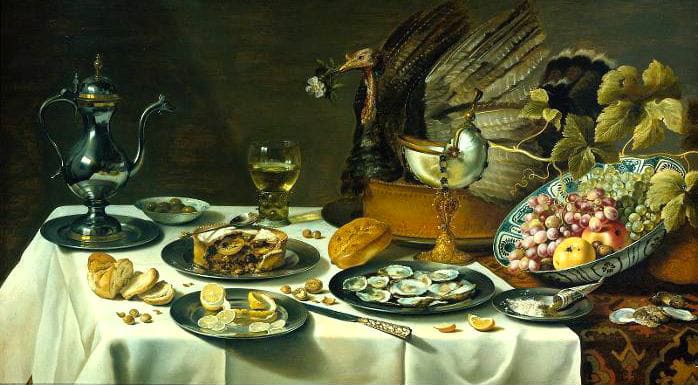Monday, November 26, 2012
Pieter Claesz: Master of Haarlem Still Life
Pieter Claesz
Tabletop Still Life with Mince Pie and Basket of Grapes, 1625
oil on panel,
Private collection
Pieter Claesz: Master of Haarlem Still Life is the first international exhibition dedicated to the work of one of the most important 17th-century Dutch still-life painters. The exhibition was on view at the National Gallery of Art—the only U.S. venue— from September 18 through December 31, 2005.
Pieter Claesz featured 28 still lifes by Claesz (1596/1597–1660) from all phases of his career. It included more than 20 works by his predecessors and contemporaries, as well as glass, pewter, and silver objects of the sort found in Claesz’s still-life paintings. The works on view are drawn from museums and private collections in Europe and the United States, and together they provide a magnificent overview of this master’s work, who created visual feasts that delight the eye and whet the appetite.
The exhibition was presented earlier with variations at the Frans Hals Museum, Haarlem (November 27, 2004, through April 4, 2005), and at the Kunsthaus Zürich (April 22 through August 22, 2005). The exhibition was organized by the National Gallery of Art, Washington, the Frans Hals Museum, Haarlem, and the Kunsthaus Zürich.
The Exhibition
Pieter Claesz: Master of Haarlem Still Life was arranged chronologically and stylistically in the Gallery’s West Building Dutch Galleries and Cabinet Galleries.
Introduction
The earliest paintings by Claesz are carefully composed still lifes depicting food, tableware, and smoking and drinking utensils. While most of Claesz’s still-life paintings are modest in size, later in his career he also painted large banquet scenes brimming with sensuous foods and elegant tableware, such as
Still Life with Peacock Pie (1627). The Dutch made magnificent game pies for festive occasions, decorating the exterior of peacock, turkey, and pigeon pies with feathers and flourishes. Later in his career, Claesz collaborated on a number of still-life paintings with his Haarlem contemporary Roelof Koets, with whom he painted the large-scale banquet piece Still Life with Large Roemer and Fruit (1644). Claesz painted the left side of the composition while Koets executed the grapes and apples at the right. Also present in the first room of the exhibition were works by Claesz’s predecessors and contemporaries Osias Beert the Elder, Floris van Dijck, Willem Claesz Heda, and Gerret Willemsz Heda.
Pictorial Innovations and Vanitas Imagery
Tabletop Still Life with Mince Pie and Basket of Grapes (1625) (above) demonstrates a number of Claesz’s pictorial innovations. The vantage point is lowered, the perception of spatial depth increased, and the composition more unified in comparision to the previous generation’s work. Around 1625 Claesz began to paint “vanitas” compositions as a reminder of the transitory nature of life.
In Vanitas Still Life (1625) the candle and watch allude to the passage of time, while the skull and cut flower evoke the inevitability of death. Such images acted as a warning against attachment to material possessions and earthly pleasures.
Monochrome banquets
Claesz pioneered the development of the monochrome tabletop still life (the so-called “banketjes”)—quietly restrained works composed in sober tones yet imbued with an extraordinary sense of naturalism.
In Banquet Piece with Pie, Tazza, and Gilded Cup (1637), Claesz included incidental details, such as crumbs, nutshell remnants, and a disarrayed napkin, to suggest that a meal has been interrupted. In this work he carefully places a spoon on top of a partially eaten meat pie as an invitation to the viewer to participate in the feast. In the “banketjes,” Claesz relied on a monochrome palette to present the subtlest refinement of color and tone.
The actual cup of the Guild of St. Martin depicted in the monochromatic Still Life with the Covered Cup of the Haarlem Brewer's Guild (1641) will be on display alongside the painting.
Sumptuous Still Lifes: Unlike the simple repasts depicted in his breakfast pieces, Claesz’s later compositions are often quite elaborate, filled with a variety of foods, glasses, and serving platters dramatically strewn across the table, as seen in Sumptuous Still Life with Roast Capon and Oysters (1647).
Pieter Claesz (1596/1597–1660)
Pieter Claesz was born in Berchem, a village near Antwerp. Almost nothing is known of his early years, including the names of his parents or the identity of his teacher, though it is likely he studied in Antwerp. Around 1621 Claesz moved permanently to Haarlem, a major Dutch art center that was home to many distinguished artists, among them several still-life painters, who benefited from the patronage of the town’s wealthy citizenry. Claesz’s innovative ways soon gained recognition. Leading families of Haarlem acquired his paintings, displaying them prominently in their houses. Claesz was a prolific painter who signed most of his pictures with the monogram PC. Claesz’s son, Nicolaes Pietersz Berchem, became an important landscape artist in the mid-1600s.
Exhibition Curator, Related Activities, and Catalogue
The curator of the exhibition in Washington was Arthur K. Wheelock, Jr., curator of northern baroque painting at the National Gallery of Art since 1984 and curator of such important Gallery exhibitions as Johannes Vermeer (1995–1996), Jan Steen: Painter and Storyteller (1996), Gerard ter Borch (2004), and Rembrandt's Late Religious Portraits (2005).
Pieter Claesz: Master of Haarlem Still Life by Pieter Biesboer, Martina Brunner-Bulst, Henry D. Gregory, and Christian Klemm is published by Waanders Publishers, Zwolle. The 176-page, hardcover catalogue includes 80 color illustrations and 20 black-and-white reproductions.
Still Life with Turkey Pie
Still Life with Oysters
More Images







